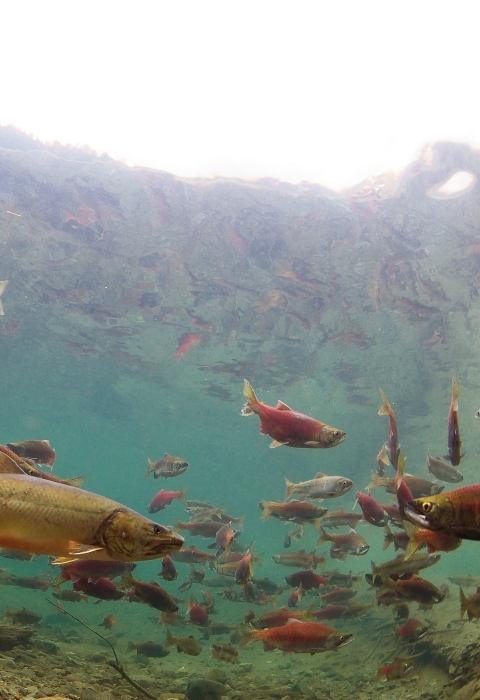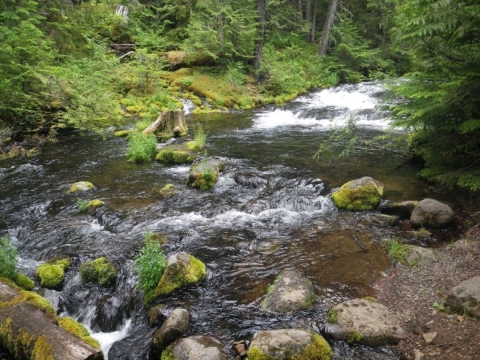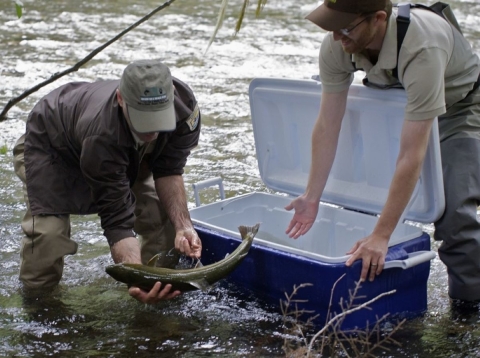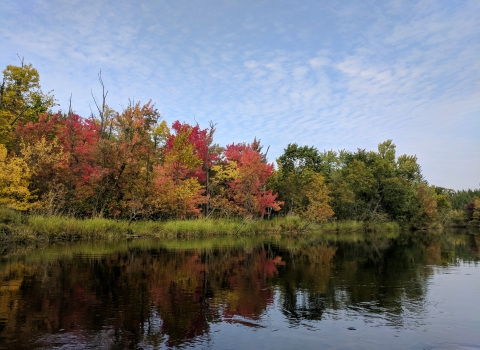This story was written by Science Applications Program Directorate Fellow, Amanda DeVleeschower. Learn more about Science Applications Program here.
What do you look for in a new home? If you were a bull trout (Salvelinus confluentus), you’d want rivers and streams that meet the four Cs – cold, clean, complex and connected habitat.
Populations of this Pacific Northwest native have been impacted by reduced habitat quality, physical barriers to river migration and even competition with non-native trout species. Climate change multiplies these threats by increasing water temperatures and reducing water available for habitat. For fish that love cold, clean water like the bull trout, warming waters can mean successful reproduction is no longer possible. The combination of these threats has resulted in bull trout populations declining to levels that required them to be listed as threatened under the Endangered Species Act. Pacific Northwest rivers have been increasingly hard to call home for bull trout.
The Clackamas River, located in northwestern Oregon, was once home to a thriving fish community that included the bull trout. But by 1963, this native fish had disappeared from the river and was locally extinct. Since then, habitat restoration efforts have improved the river, reduced migration barriers and limited the number of non-native trout species. All this work to make the Clackamas River, once again, a good home for native fish paid off. In 2007, a feasibility study conducted by the U.S. Geological Survey and its partners indicated that reintroducing bull trout to the Clackamas River was biologically feasible and would help the recovery of this species by providing the species with suitable habitat that could help them withstand expected climate changes in the region.
In 2011, the U.S. Fish and Wildlife Service (USFWS) partnered with the Oregon Department of Fish and Wildlife (ODFW), Confederated Tribes of the Warm Springs, U.S. Forest Service, Bureau of Land Management, and other local partners to start bringing back the bull trout to the Clackamas River. The goal is to re-establish a self-sustaining population by the year 2030.
The first step was to find bull trout that could be moved to the Clackamas River without harming the population from where the trout are being taken. One way scientists determine the strength of a bull trout population is through redd counts. A redd is a location where a female will remove gravel to later deposit eggs over a period of a few days. On average, there are 2.3 adult bull trout per 1 redd, which allows for an estimation of spawning adults in a population. The ODFW conducted annual redd count surveys to determine which local rivers had large enough numbers of bull trout that some could be relocated to the Clackamas River. The threshold for determining if the donor population is strong enough to allow transfer is currently 800 spawning adults. The ODFW found more than 1,000 spawning adults within the Metolius River, which is managed by the Confederated Tribes of the Warm Springs. The Metolius River was an ideal donor source since the bull trout population was so healthy.
The next step in reintroducing bull trout was to ensure each individual trout was healthy enough to be moved to the Clackamas River. This benefits both the trout itself, as well as other fish living in the Clackamas River. Each bull trout taken for relocation was screened to minimize any disease being transferred into the Clackamas River. In June 2011, the first bull trout were ready to move to their new home.
Before releasing the trout, scientists tagged them with PIT tags/radio tags to track their location. Tracking the bull trouts’ location was vital to understanding their survival rates and which parts of the river they were using. It even allowed scientists to learn more about what the trout were doing at locations, such as spawning or feeding. After this preparation, all scientists could do was wait to see if the translocated fish made the Clackamas their home once again.
Just a few months later, in October 2011, for the first time in more than 50 years, a bull trout was observed spawning in the Clackamas River. Shortly after, researchers identified five bull trout redds. With this success under their belt, researchers pushed forward with their goal of a self-sustaining population by 2030. Between 2011 and 2016, 2,836 fish were successfully transferred to the Clackamas River and tagged for PIT tags/radio tags for successful location tracking. By 2019, redd counts increased 18.6%, with a total of 93 redds being counted throughout the Clackamas River.
After stocking bull trout for several years, scientists are now monitoring the reintroduced population to determine their survival and reproduction success. Many bull trout seem to be faring well in the Clackamas River, and there is evidence that they are moving from introduction sites to other parts of the river. However, a remaining challenge with the reintroduction has been determining the fate of juveniles emerging from redds in the Clackamas. Despite efforts by the Service and our partners, we have not been able to find juveniles once they leave the redds. We thus know the adults we placed in the system are surviving and spawning and that their progeny are surviving to the embryonic stage, but do not know whether they are surviving or remaining in the system beyond that. The populations in the river will be continually monitored by environmental DNA (eDNA), redd surveys, and census spawning surveys.
Through scientific research, collaboration and hard work, bull trout now call the Clackamas River home after a half century absence.
The Regional Climate Change Coordinator and Fish and Wildlife Biologist Michael Hudson noted how important this project is when looking towards the future. “This reintroduction project provides us the opportunity to learn about bull trout reintroduction and how we can apply that elsewhere,” said Hudson. “What didn’t we think about? What should we think about next time?... As we move forward with reintroduction projects, these projects will continue to provide us feedback on how we want to be thinking about climate more.”
Reintroducing species to habitats that are projected to be suitable in the future is an important management tool for adapting to climate change climate change
Climate change includes both global warming driven by human-induced emissions of greenhouse gases and the resulting large-scale shifts in weather patterns. Though there have been previous periods of climatic change, since the mid-20th century humans have had an unprecedented impact on Earth's climate system and caused change on a global scale.
Learn more about climate change . Check back in 2030 to learn if this multiagency effort to bring back the bull trout to the Clackamas River has been a success.




